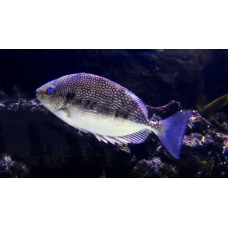Latin name
Siganus javus
Other name
Java rabbitfish, blue-spotted spinefoot, blue-spotted trevally, Java spinefoot, white-spotted rabbit-fish.
Identification
Streaked spinefeet have a laterally compressed body that is slightly less than half its normal length. The head is relatively small for a rabbitfish, with a deep body and a small depression above the eyes. The anterior nostril has a small triangular flap that extends backwards halfway between the anterior and posterior nostrils. In front of the dorsal fin there is a forward projecting spur on the back of the head. The cheeks are covered with thick scales.
Features of fish fins
The dorsal fin of these fish has 13 spines and 10 soft rays, while the anal fin has 7 spines and 9 soft rays. The caudal fin is pointed.
Fish colouring
The overall colouration of this species is grey, tending to whitish on the lower body, but the cheeks and lips are yellow. There are numerous small white spots on the head and upper body, irregularly shaped sinuous stripes from the middle to the bottom of the sides, and a blackish area that covers most of the caudal fin. The dorsal, anal and pelvic fins have golden spines and rays, while their webbing may be dark or golden and the pectoral fins may be golden-hyaline.
Distribution
Streaked spinefoot is found from the Persian Gulf west to the Solomon Islands and Vanuatu, north to Taiwan and south to northern Australia. In Australia it has been recorded from Darwin in the Northern Territory to Townsville in Queensland.
Habitat
A marine, tropical, oceanodromous species. It is found in shallow coastal waters, brackish lagoons and rocky and coral reefs from 1m to 25m deep.
Size
The maximum total length of this species is 53 cm (21 inches), although 30 cm (12 inches) is more typical.
Behavior
These fish swim in small schools of up to 10 individuals. They often rest in mid-water at depths of 2 to 6 m (6 feet 7 inches and 19 feet 8 inches) when not feeding.
Food and feeding habits
They feed mainly on bottom algae and bits of algae floating in the water column.
Reproduction
The Streaked spinefoot lays sticky eggs.
Fishing
These fish are caught using seines, gill nets and fixed traps and are sold fresh.
Relationship with a person
The dorsal, anal and pelvic spines of the Streaked Spinefish have grooves containing venom glands. Wounds inflicted by these spines can be relatively painful to humans, but are not usually dangerous. These fish use the spines for self-defence.
| Classification | |
| Phylum | Chordata |
| Class | Actinopterygii |
| Squad | Perciformes |
| Family | Siganidae |
| Genus | Siganus |
| Species | S. javus |
| Features | |
| Conservation status | Least Concern |
| Habitat | Pelagic |
| Life span, years | No information |
| Maximum body weight, kg | No information |
| Maximum length, cm | 53 |
| Sailing speed, m/s | No information |
| Threat to people | Edible |
| Way of eating | Planktonophage |
Streaked spinefoot
Tags: streaked spinefoot



